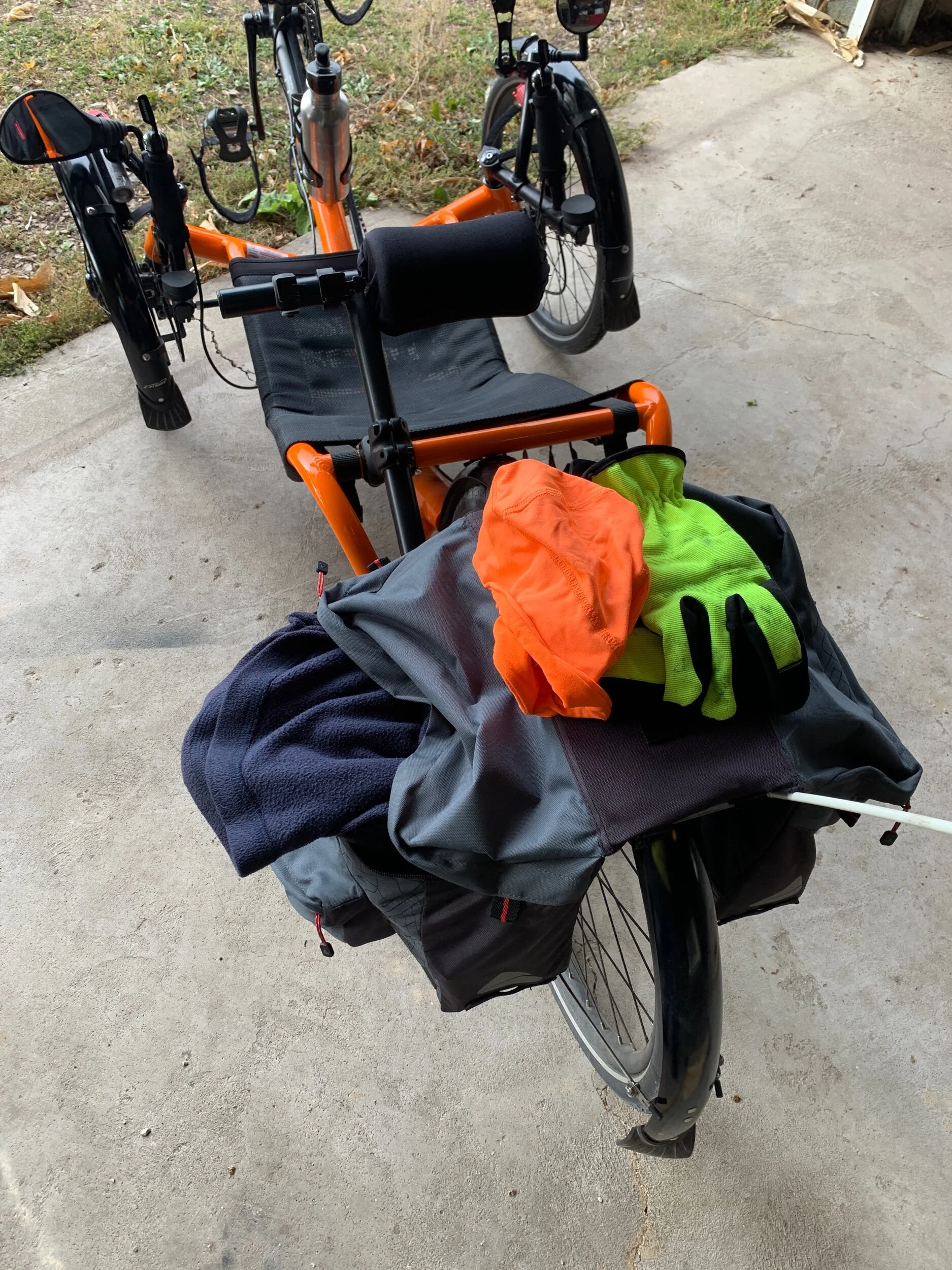The days are getting shorter, the wind is picking up on the prairie, and there is frequently moisure in the air. For an astonishing segment of the population here in the US what that means is that it’s time to put pumpkin spice in, well, everything. For me, it means something a little more like this:
Yup - this is when I start breaking out the cold weather gear.
What you see in the picture is what I would consider stage 1 (on a somewhat informal basis). With the progression into actual fall weather, I break out low-level warming gear such as a skull cap (in orange of course), full-finger gloves (I need to find orange versions of these - right now I’m pretty sure I clash), and somewhat heavier outer-gear. That consists of uninsulated nylon pants (which also help when things get a little damp) and a top that is a bit heavier than a rash guard. I also pack in a well-weathered, but still effective, Old Navy fleece in the pannier bags in case I’ve miscalculated in my original clothing selection.
Oh - and socks. I start wearing socks. First with my sandals (I know - fashion crime), and then I’ll move to shoes. And it’s actually been cool enough here in northern Illinois over the past week to warrant shoes twice so far.
A lot of questions come up in cycling groups around this time of year about what to do as the weather starts to turn. Answers and discussion range from finding ways to ride inside to how to cope with the cold, including the inevitable question about how cold is simply too cold for cycling.
Within that mix are both objective and subjective answers. There is a lot of objective information about how to cope with the cold weather - most of it has to do with selecting the right clothing for the job, and perhaps supplementing with chemical warmers in a pinch. And, frankly, human beings have been doing this successfully for a very long time - heck, if Maria Leijerstam can make it across Antarctica to the South Pole, odds are there’s a level of cold weather gear that will technically keep you safe in the cold.
But how cold is too cold? That’s the subjective part. Every person has their own level of tolerance for chill, and it’s important to know yourself in that regard. As you consider that, however, the thing to keep in mind with respect to cool - and cold - weather riding is that, for the most part, it is not a cold activity.
This may seem counter-intuitive to people who haven’t engaged in outdoor exercise in the chilly seasons. After all, if the mercury is dipping down and hiding, that means it’s cold outside; ipso facto, if you go outside you, also, will be cold.
This might be bolstered by experience participating in other outdoor activities. For example, many of us in cold weather climates may have gone sledding, or downhill skiing, and experienced the progressive chill that goes with those activities. This is why, at the end of the day skiing or sledding, you retreat to the chalet (or your house) for a nice cup of cocoa or a hot toddy to warm up.
But if you did do such activities, you may have, as I once did, also looked askance at the folks sliding their skis across the flatlands and wondered what earth were they thinking? Why would one tolerate the cold without the benefit of the adrenaline rush that comes from sliding down a hill at potentially inadvisable speeds?
The thing is, those folks on their cross country skis had a secret: they weren’t tolerating the cold. In fact, they weren’t cold at all. If it’s very cold out, the first few minutes getting started on your skis - getting everything strapped on and starting to slide - might be a little chilly. But a few minutes into the actual activity, your body becomes a furnace. What you did not see from the distance of the ski hill is that the cross country folks were not only not cold, but they were periodically unzipping and opening things up in order to cool down.
And this the deal with cold-weather cycling (and, likely, any cold-weather cardio activity). Temperature-wise, the primary difference between cross country skiing and winter cycling is being prepared to deal with the wind that you generate when riding. Depending upon what you are riding and what the road conditions are, it is quite possible to hit speeds up to 20-30 mph in the winter, which essentially means you are creating your own wind-chill. And mostly this means that you want to plan to protect your extremities.
So - some food for thought as you start to ask about what to do as the cold weather turns. There’s nothing wrong with getting things set up for indoor exercise on your machine - if that’s what works for you, that’s great. But if you are just worried about being cold, hopefully this will provide some food for thought.
If so, start doing your searches online for how to gear up properly for riding in the cold - there are more resources out there than you’d think (and I may add some to this site as well). If you do, maybe we’ll run across each other - I’m constitutionally unable to stay inside, and if I even start thinking about it, it makes my trike sad, so I’ll be out there.
